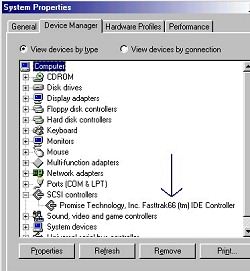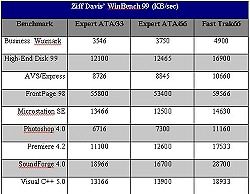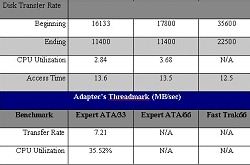| Fast Trak 66
by John Reynolds |
||||
|
The FastBuild utility includes other options in its main menu, such as Define Array, which allows you to manually create the array you desire, Delete Array, Rebuild Array, for when, and if, an array becomes unstable or plagued with errors, and Controller Configuration. This last menu option allows for the DMA burst rate to be set to either Auto (default setting), Turbo (fastest setting), or Fast (for reliability). Also displayed are system resources, and, speaking of, the Fast Trak66 is a PnP device that uses only one interrupt as opposed to the two used by your motherboard's onboard IDE controllers. The Fast Trak66 supports DOS, Win 3.1x/95/98, and NT 3.5x/4.0. After setting up the striped array, I rebooted off a floppy and ran Fdisk to lay down a single FAT32 partition that would span all 18gb of available space. After formatting this behemoth, I began installing Windows 98, which detected the Promise card as a PCI RAID controller device with the SCSI symbol. Why? Because it is a SCSI controller, one that works only with IDE drives. Feed it the driver diskette and continue installing the operating system.
 Having benchmarked a single WD Expert drive in a recent review, I'll include these scores for easy comparison with how drive performance was affected while running in a RAID 0 array with the Fast Trak66. Again, Ziff Davis' WinBench 99 and Adaptec's Threadmark were used for synthetic benchmarks, each score being the average of three test runs. I've also decided to throw some real-world testing into the mix; though unscientific in its approach, I thought simply recording the load times for Windows might be of interest to some of COMBATSIM.COM™ readers. As for the testbed, the system was identical to what the Expert was benched on in its own review:
|
 Impressive scores, to say the least. Of noteworthy interest to me were the access times; older drives tested on the original Fast Trak saw their access times rise considerably due to unsynchronized spindles, yet the Experts and their 7200rpm spindle speeds zipped right along. And Windows 98 load times dropped from an average of 34 to 25 seconds. But unfortunately, just as when running the Fast Trak66 as a ATA/66 controller with one Expert drive, I couldn't get Threadmark to complete its testings. Worse yet, the cpu utilization test in WinBench's Disk Inspection test also refused to run. Growing a tad worried, and suspicious, I resorted to HD Tach v2.60, a benchmark that doesn't appear to be as widely used or respected as either Threadmark or WinBench. It reported an 11.7% CPU utilization, almost twice what the benchmark showed a single Expert consumming. Moreover, I checked the Report CPU Utilization in WinBench's test settings and ran the Business Disk test three more times. It showed an average of 38.9% CPU usage, but this wasn't much higher than what a single Expert posted. Bearing in mind that this wasn't a dedicated test used explicitly for determining CPU utilization, and the fact that Threadmark simply refused to run, I can only fall back on the reasonable assumption that a striped array running on a Fast Trak66 doesn't devour significantly more of your system's processor than a single ATA hard drive. Worth noting, I ran a fairly broad suite of different games, some quite CPU-intensive, and had the controller been draining the processor this would've shown in the games' overall performances, but Quake 2 and Unreal benchmarks were consistent, as was WW2 Fighters' frame counter. So do I recommend the Fast Trak66? Go to Page Three |
|||
|
Copyright © 1997 - 2000 COMBATSIM.COM, INC. All Rights Reserved. Last Updated July 8th, 1999 |
||||

